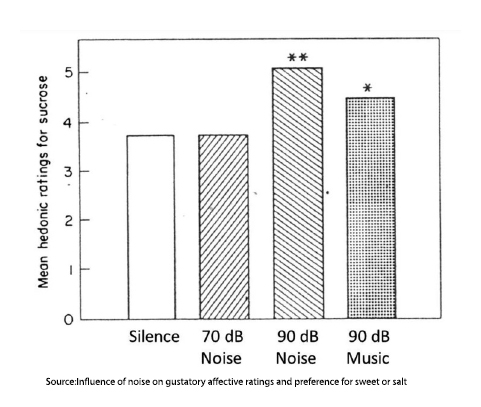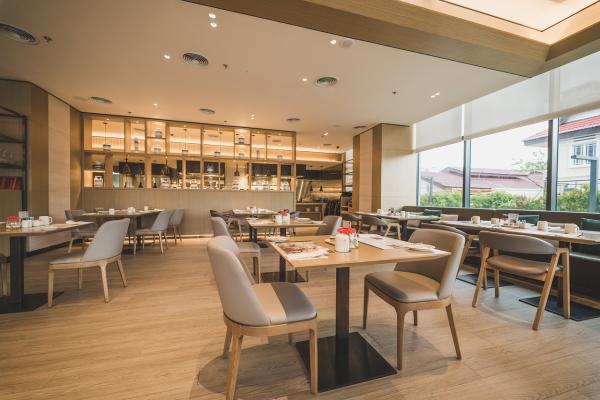Restaurants often have varying noise levels; typical noise levels range from 65 to 85 dB(A), making it hard for patrons to hear and understand. While older adults are more sensitive to louder sounds than the young, all of us are affected by the surrounding soundscape. While studies have shown that louder music can promote increased consumption over shorter time frames, there is a loudness point at which our behavior changes. As the sounds increase over normal conversation, restaurant patrons leave more quickly but spend less, in the range of 25% less. Finding a sonic sweet spot is vital to a restaurant's bottom line.
Sound, it's just energy on the move
Sound is a form of energy characterized by vibrations in air, water, or even solids that occur at varying intervals. These “waves” are sensed by our ears and perceived as “sounds” – in a sense, we hear in our brain; the ear only translates those waves into signals we interpret as sound.
Those energetic alterations in the air propagate from their source in a regular pattern, diffusing out in all directions. As they move further from the source, sound waves lose energy, but within a roughly 50-foot area, they have enough energy to interact with the environment, including other sound waves. A sound wave is reflected, bounced back, when it strikes an object, like a wall. It can then mix with waves from the original sound, creating reverberation. [1]
The energy of a reflected sound wave is always a bit less than the original. The surface reflecting the wave absorbs varying amounts of the wave’s energy – hard surfaces, absorbing the least, reflecting the most; soft, fluffy surfaces, absorbing more, reflecting less.
Loudness of sound is a measure of a sound wave’s energy, specifically, the amount of energy, described as “amplitude,” experienced by our ear. Amplitude increases loudness exponentially [2], and the sensitivity of our ears further impacts our perception of loudness; those with hearing loss perceive sounds to be less loud
We measure the loudness of a sound in decibels (dB). Normal breathing is at 10 dB, a whisper at 30 dB, and our day-to-day conversation at 60 dB. 70 dB is a loud vacuum cleaner, and 80 dB is the sound of city traffic. And remember, every 10 dB increase doubles our perceived loudness.
Noise changes how we taste and chew
I have written on entrainment several times (here, here, and here) – how we incorporate and synchronize with the sounds around us, altering our physiological responses, especially with the rhythmic sounds of music. As it turns out, the soundscape of restaurants can change perceptions and behavior.
The data on alcohol consumption stands on the firmest of ground. In a study of 30 participants given hearing tests after drinking various amounts of alcohol
“Alcohol specifically blunts lower frequencies affecting the mostly 1000 Hz, which is the most crucial frequency for speech discrimination.”
In another study, 40 pairs of male drinkers drank in a bar with a “normal” music level of 72 dB and a bar where the music was significantly louder, 88 dB. As the loudness increased, the patrons drank 30% in 20% less time – all good for a restaurant's bottom line. Of course, one explanation is that the pairs sought to flee the loud sounds by downing those drinks more quickly.
 Another study considered the impact of loudness on the perception of sugar and salt. Here, 10 male participants listened to music or white noise at varying decibel levels and rated their taste sweetness or saltiness. While their perception of salt remained unchanged, sucrose was perceived as sweeter, and loud “unpleasant” white noise caused the greatest response. That said, the literature on the effect of sound on our experience of taste is a mixed bag. Perhaps that is due to the ambiguous term “noise.” After all, one person’s music is frequently a noise-filled cacophony to others, and sometimes, not while eating; you just have to pump up the volume.
Another study considered the impact of loudness on the perception of sugar and salt. Here, 10 male participants listened to music or white noise at varying decibel levels and rated their taste sweetness or saltiness. While their perception of salt remained unchanged, sucrose was perceived as sweeter, and loud “unpleasant” white noise caused the greatest response. That said, the literature on the effect of sound on our experience of taste is a mixed bag. Perhaps that is due to the ambiguous term “noise.” After all, one person’s music is frequently a noise-filled cacophony to others, and sometimes, not while eating; you just have to pump up the volume.
Noise triggers a more generalized stress response, which, if maintained, increases blood pressure and heightens anxiety. And it seems that louder sounds cause people and rats to consume food faster, like alcohol.
For those with a public health interest, noise also seems related to waist size. In a 4-year study in Sweden,
“For every 10-dB increase in the road traffic noise levels, there was a 3-cm increase in waist size. More dramatically still, those exposed to loud airplane noise had a waistline that was, on average, 6 cm larger.”
The Lombard Effect, a speech-changer
In 1909, Étienne Lombard, a French ear specialist (otolaryngologist), performed an experiment where he asked individuals to speak in a conversational tone while increasingly loud sounds were played into one ear. He found that loud sounds caused individuals to speak louder, adjusting the pitch and speed of their speech and pronunciation to be understandable over the “noise.”
As a restaurant fills with patrons, the conversational sounds rise by 3 dB for a doubling of occupants. The Lombard Effect ensures that this becomes a positive feedback loop where increasing background decibels leads to louder voices, leading to more background decibels.
Relaxing or Taxing - Finding the Sweet Spot
While most restaurants provided little sonic background beyond the sounds of plates and cutlery, that seemed to have changed in the mid-1990s. In Babbo, one of Mario Batali’s restaurants, he played the same music for his customers that he and his colleagues played while working. (Having eaten at Babbo, I can attest to that, and I found it odd that I was eating in a “white-linen” restaurant to the sound of the Stones.) The idea, if not the playlists, was adopted by other chefs, and a “curated” sonic landscape became part of the dining experience.
While the primary source of exogenous sounds in a restaurant are from the patrons, changes in the “built” landscape, the restaurant's interiors, also have an impact. In seeking a more modern, slick architectural vibe, restaurants have introduced many hard surfaces, which very effectively reflect sound.
“Spare walls, stone floors, and shiny, cold zinc-topped tables amounting to an ideal environment for the propagation of decibels… a crescendo that’s not unlike the approach of a train. All that’s missing is a horn and a flashing light.”
- Paul Reidinger, restaurant critic
In addition, the trend towards an open kitchen provides patrons with a view of the kitchen and the propagation of kitchen sounds, adding to the sonic landscape.
As the decibels rise, our brains work harder to separate our companion’s words from the background noise. Paying attention requires work, and prolonged exposure to loud noise wears us out. While the common narrative is that this is more a problem for the oldsters among us, it is true for all of us – the hearing impaired, and that includes those with hearing losses or increased sensitivities as with autism, are just the canaries in this sonic coal mine.
There are several ways in which restaurants might reduce their soundscape. Since the patrons are the largest noise source, we might institute an acoustical capacity, “the maximum number of persons in a room for sufficient quality of verbal communication,” for a restaurant. But this potential loss of revenue is most likely a non-starter. More practically, but with higher costs, the design of restaurants could include softer surfaces, carpets instead of wood, wall tapestry, booths that break up sounds, and absorbent ceilings. All contribute to a dining table “microclimate,” but all risk creating an atmosphere more akin to office cubicles than dining out.
There is even a more expensive, high-tech solution. An array of microphones throughout a restaurant continuously samples the ambient sounds and, like noise-canceling headphones, feeds back sounds to alter the ambient soundscape. [3]
The battle against restaurant noise is about maintaining ambiance and ensuring customer satisfaction and retention. Restaurants risk driving away patrons with an overwhelming din, turning what should be an enjoyable meal into an exhausting auditory experience.
[1] The reverberation of sound waves taking longer than about 0.1 seconds to return to your ear is termed echo.
[2] Loudness = Amplitude2
[3] Here is an explanation of one of these sophisticated systems applied to an auditorium
Sources: Noise and its impact on the perception of food and drink Flavour DOI: 10.1186/2044-7248-3-9
Why Restaurants Are So Loud, And What Science Says We Can Do About It Washington Post
Lombard effect, intelligibility, ambient noise, and willingness to spend time and money in a restaurant amongst older adults Scientific Reports DOI: 10.1038/s41598-022-10414-6




